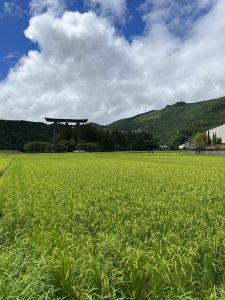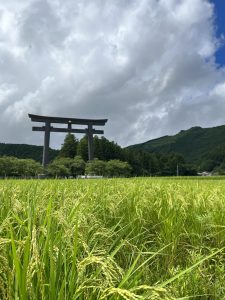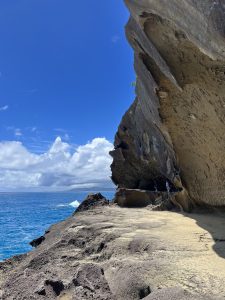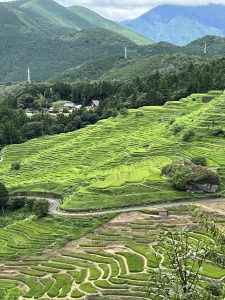弾丸ドライブでしたがリフレッシュできました。(愛知県名古屋市千種区姫池通 骨董買取 古美術風光舎)
2023.08.10
みなさまこんにちは、スタッフYでございます。
いきなりですが、先日親戚が出張にてこちらへきておりまして。行きたいところがあるということで、熊野弾丸ドライブへ行って参りました。
名古屋から4時間くらいかかったでしょうか笑。親戚は都内在住なのですが、都内からですと頑張っていけるとしたら伊勢志摩くらいまでだそうでして。伊勢神宮に訪れるだけでも新幹線電車を乗り継いてはるばる旅をした感じとのことでして、いつもその先の熊野方面が気になりながら引き返します。志摩のその先はどうなっているのか大変気になるそうです。
そして早朝から車を飛ばし、やってまいりました念願の熊野方面。スケジュール的にど観光スポットを行けるだけ行こうということになりまして、とりあえず丸山千枚田を経由して熊野本宮大社へ向かいました。かなり遠い道のりではありましたがそこは一気に到着した風に割愛いたします。
今回の弾丸ドライブで、とても印象的だったのは青々とした稲と清流でした。
まずは訪れた丸山千枚田。
結構山深いハードな道を抜けていったのですが、この風景が現れた時は、秘境を見つけたような気持ちになりますね。いやいや、これはマチュピチュか。
ここからの風景が一番全景を捉えることができたのですが、今の季節は稲が青々と育ち美しい。
ご存じの通り、丸山千枚田(まるやませんまいだ)は、紀和町丸山地区の斜面に幾重にも描かれた棚田でして、日本の棚田百選にも選ばれております。この風景、どこかのカレンダーなどで一度は目にいたりして、カレンダーで見た風景に訪れるとなんだか感動しますね。
この棚田がいつ頃造成されたかは不明ですが、西暦1601年(慶長6年)にはすでに2,240枚の田があったという記録があるのですが、昭和40年代半ばから始まった稲作転換対策による杉の植林や昭和50年代以降の過疎・高齢化による耕作放棄地の増加によって、平成初期には530枚までに減少。
地元住民たちは、自分達の代でこの貴重な文化遺産を無くすわけにはいかない、素晴らしい景観と農耕文化を後世に残し伝えていかなければならないと立ち上がり、平成5年に丸山地区住民全員による丸山千枚田保存会を結成し、丸山千枚田の復元と保全活動が始まりました。そして、平成8年度からは千枚田の一部を利用して千枚田オーナー制度によって運営を行ったりしているようでして、私の今見ているこの景色は、様々な取り組みや努力によって保たれた景色なんですね。
近づいてみますと、一枚一枚の田は小さく、それらが崩れないよう人の手で丁寧に石が積み上げられております。雑草も丁寧に刈られていたりとこれらを保ち稲を育てていくこと、そしてこの景色を保つことはとても大変だなとわかります。そして早くも穂先には稲が。刈り取りはではまだまだですが、もう少しこの熊野の涼しい風(ここは涼しかったです。)に揺られながら、小さな田いっぱいに穂を実れせてほしいものですね。
そして、世界遺産熊野本宮大社もめざして清流熊野川と並走でしたが、清流という名にふさわしいゆったりとした流れに、こんなに美しいところがまだ日本にあったのかとしばらく車窓に張り付いておりました。
そして、やっと熊野本宮大社へ。こちらは熊野本宮大社の大斎原(おおゆのはら)ですが、大斎原は熊野本宮大社が最初に築かれていた場所にあります。熊野川、音無川、岩田川が合流する中洲に位置しており、その歴史は2000年以上前に遡ります。しかし、未曾有の大洪水が明治時代に起こり、ほとんどの建物が流失。奇跡的に残った上四社が現在の場所に移築され、この日本一の鳥居は今も悠然とここに残っております。そして大斎原(おおゆのはら)のそばにも青々と穂の実った稲が。

こちらも刈り取りにはまだまだですが、大鳥居の下、爽やかな熊野の風と陽をいっぱい浴び、大きく育ってほしいものです。

熊野弾丸ドライブ、遠いかなと機会がなかなかなかったのですが、これは思い切って訪れてよかったです。青い空と海と川と稲とちょっと涼しい熊野の風、そして熊野本宮大社のおかげでたいへんリフレッシュができました。
それでは、ごきげんよう。

Hello everyone, this is Staff Y.
I know this is sudden, but my relative was here on a business trip the other day. I went to Kumano for a bullet drive.
It took about 4 hours from Nagoya. My relative lives in Tokyo, but I heard that from Tokyo it would only take him as far as Ise-Shima, if he could make it there at all. They said that just to visit Ise Shrine was like taking a bullet train all the way there, and they always turn back, wondering about the Kumano area beyond that. He is very curious about what lies beyond Shima.
So we drove there early in the morning, and here we are in the Kumano area, which we had longed for. We decided to visit as many tourist spots as we could on our schedule, so we headed to Kumano Hongu Taisha Shrine via Maruyama Senmaida for the time being. It was quite a long way, but I will skip that part as if we arrived at once.
What was very impressive on this round trip was the lush green rice fields and clear streams.
First, we visited Maruyama Senmaida.
We went through a hard road quite deep in the mountains, but when this scenery appeared, I felt as if I had found a secret place. No, no, this is Machu Picchu.
I was able to capture the most panoramic view from here, and the rice plants are growing lush and beautiful in this season.
As you know, Maruyama Senmaida is a series of terraced rice fields on the slopes of the Maruyama district of Kiwa Town, and has been selected as one of the 100 best terraced rice fields in Japan. I have seen this scenery in some calendars, and it is very moving to visit a scene that I have seen in a calendar.
It is unknown when these terraced rice paddies were created, but records show that there were already 2,240 rice paddies in 1601 A.D. However, due to the planting of cedar trees in response to rice farming conversion measures that began in the mid-1960s and the increase in abandoned farmland due to depopulation and aging since the 1975s, the number of rice paddies decreased to 530 in the early Heisei period. The number of abandoned plots decreased to 530 by the beginning of the Heisei era.
The local residents decided that they could not afford to lose this precious cultural heritage in their generation, and that they must preserve the wonderful scenery and farming culture for future generations. Since 1996, a portion of the Senmaida has been used for the Senmaida Owner System, and this scenery that I am seeing now has been preserved through various efforts and endeavors.
As I approached, I saw that each rice paddy was small, and stones were carefully piled up by human hands to prevent them from collapsing. The weeds are also carefully cut, and you can see that it is very hard work to keep the rice growing and to maintain this view. And the rice is already at the tip of the ear. It is still too early to reap the harvest, but we can enjoy the cool Kumano breezes (it was cool here) for a little while longer. I hope that the small paddy fields will be full of ears of rice while being swayed by the cool Kumano breezes (it was cool here).
We drove alongside the clear Kumano River, aiming for the World Heritage Kumano Hongu Taisha shrine.
I was looking out the window of the car for a while, wondering if such a beautiful place still existed in Japan, and finally arrived at the Kumano Hongu Taisha Shrine.
This is Oyunohara of Kumano Hongu Taisha Shrine. Oyunohara is where the Kumano Hongu Taisha Shrine was first built. Located on a sandbar where the Kumano, Otonashi, and Iwata Rivers converge, it dates back more than 2,000 years. However, an unprecedented flood occurred during the Meiji period (1868-1912), and most of the buildings were washed away. Miraculously, the four remaining Kamishiyasya shrines were relocated to their current location. Near Oyunohara, Japan’s largest torii (shrine gate), there are also lush green ears of rice.
It is not yet time to reap the harvest, but I hope the rice will grow up under the Otorii, basking in the fresh Kumano wind and sun.
I had never had a chance to visit Kumano, thinking it would be too far away, but I am glad I took the plunge. The blue sky, the sea, the river, the rice, the cool Kumano breeze, and the Kumano Hongu Taisha Shrine refreshed me greatly.
Thank you very much for your company, even if it was only a part of it.
Have a good day.
*******************
ご実家の整理やお片付けなどをされている方のご相談などが多くございます。
お片付けなどくれぐれもご無理のないようになさってくださいませ。
風光舎では古美術品や骨董品の他にも絵画や宝石、趣味のお品など様々なジャンルのものを買受しております。
お片付けをされていて、こういうものでもいいのかしらと迷われているものでも、どうぞお気軽にご相談下さいませ。
また風光舎は、出張買取も強化しております。ご近所はもちろん、愛知県内、岐阜県、三重県その他の県へも出張いたします。
まずは、お電話お待ちしております。
愛知県名古屋市千種区姫池通
骨董 買取【古美術 風光舎 名古屋店】
TEL052(734)8444
10:00-17:00 OPEN
#出張買取#骨董#古美術#骨董品#絵画#版画#茶道具#刀剣#彫刻


